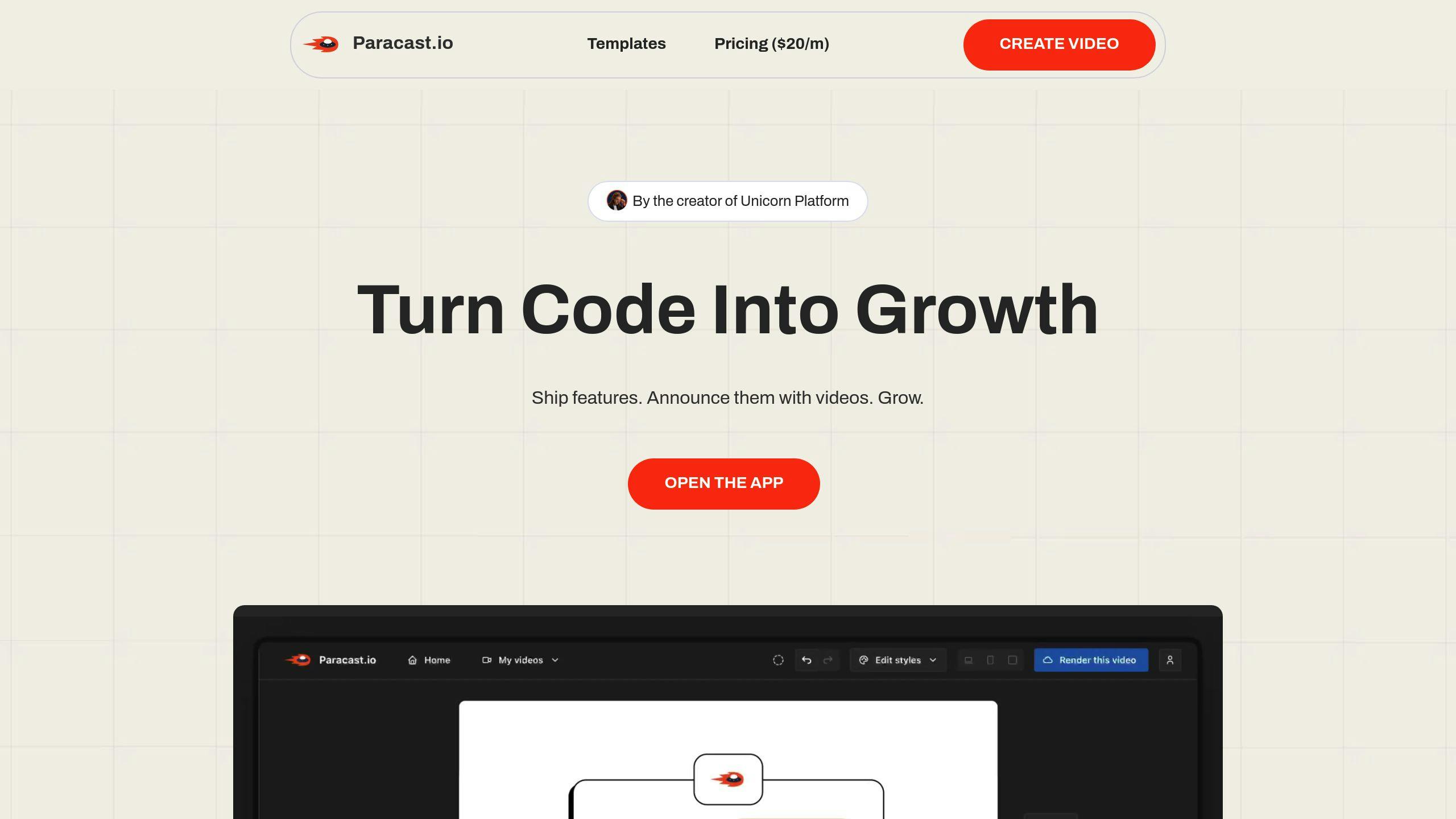Want your videos to look great and perform well on social media? Here's what you need to know for 2025:
- Why It Matters: Optimized videos boost engagement, reduce cropping issues, and improve mobile playback. 80% of users browse social media on mobile, so getting formats right is essential.
- Platform-Specific Specs:
- Facebook: 1920×1080 px for feed, 1080×1920 px for stories.
- Instagram: 1080×1080 px for feed, 1080×1920 px for reels.
- YouTube: 16:9 aspect ratio, 1080p or 4K resolution.
- TikTok: 1080×1920 px, vertical 9:16.
- Twitter (X): 1280×720 px, 2:1 to 1:1 aspect ratio.
- Key Tips:
- Use MP4 or MOV formats for quality and compatibility.
- Stick to 30 FPS for smooth playback.
- Match aspect ratios to each platform for better results.
Get your specs right and watch your engagement grow in 2025. Platforms like Paracast.io can help simplify the process with AI tools and templates tailored to each platform. Ready to optimize your videos?
Video Specs for Top Social Media Platforms
Facebook Video Requirements
Facebook remains a powerhouse for video content in 2025. To get the best results, follow these specs for its various video formats:
| Format | Specifications |
|---|---|
| In-feed | 1920×1080 px, 4GB, up to 240 mins |
| Stories | 1080×1920 px, 4GB, 15 seconds |
| Live | 1280×720 px, N/A, up to 8 hours |
Up next, Instagram's video specs bring a different set of requirements.
Instagram Video Requirements
Instagram's video features cater to different formats, each with its own rules:
- Feed Videos: Maximum size of 650MB for videos up to 10 minutes long.
- Stories: 1080×1080 pixels.
- Reels: 1080×1920 pixels with a minimum frame rate of 30 FPS.
- Live Videos: Up to 4 hours in duration.
Instagram also requires a minimum width of 500 pixels for all videos [1].
Now, let’s look at Twitter (X), which focuses on short, concise videos.
Twitter (X) Video Requirements
Twitter's video specs are designed for brevity and efficiency. Here's what you need to know:
- Recommended Resolutions: 1280×720 (landscape) or 720×1280 (portrait) [4].
- Aspect Ratio: Between 2:1 and 1:1.
- Maximum File Size: 1GB.
- Duration: Up to 2 minutes and 20 seconds.
- Frame Rate: 30 FPS recommended.
For creators producing longer, high-quality content, YouTube is the platform to focus on.
YouTube Video Requirements
YouTube supports a wide range of high-quality video formats. Stick to these specs for the best results:
| Resolution | Aspect Ratio | Max File Size |
|---|---|---|
| 1080p (HD) | 16:9 | 256GB |
| 4K | 16:9 | 256GB |
| Standard | 16:9 | 256GB |
The platform prefers videos in MP4 format [3].
Finally, TikTok's vertical-first design requires a tailored approach to video creation.
TikTok Video Requirements
TikTok videos are optimized for vertical viewing with these key specs [2]:
- Resolution: 1080×1920 pixels in a 9:16 aspect ratio.
- Maximum File Size: 287.6MB.
- Supported Formats: MP4 and MOV.
- Video Length: Up to 3 minutes (10-minute option available).
- Frame Rate: Minimum of 30 FPS [1].
Social Media Video Sizes & Ratios - Video Size Guide for 2024
Tips for Optimizing Social Media Videos
Creating videos that grab attention on social media takes more than just meeting basic platform requirements. Here are some strategies to make your videos stand out in 2025.
Match Aspect Ratios to Each Platform
Different platforms favor different aspect ratios. For instance, Instagram Stories and TikTok are designed for 9:16 vertical videos, while YouTube sticks to the classic 16:9 widescreen format. Tailoring your video to match these preferences ensures it looks great and fits seamlessly into users' feeds.
Stick to Universal File Formats
MP4 and MOV continue to be the go-to formats in 2025. They offer excellent compression, maintain video quality, and work across most devices. These formats also retain important metadata that platforms use to optimize playback and reach.
Choose the Right Frame Rate
Frame rate plays a big role in how professional your video looks. For most content, 30 fps works well. If you're creating fast-paced or action-heavy videos, bump it up to 60 fps for smoother visuals.
"Higher frame rates like 60 fps can enhance the viewing experience, especially for videos with fast-paced content. For example, YouTube recommends 60 fps for gaming content to provide a smoother and more engaging experience" [3].
Keep in mind that higher frame rates demand more bandwidth, so consider your audience's typical internet speed and device capabilities when making your choice.
sbb-itb-5bfa442
How Paracast.io Helps with Video Creation

Paracast.io makes creating social media videos easier by using AI-driven tools and ready-made templates. It simplifies the process of meeting platform-specific video requirements, saving time and effort.
AI Tools for Video Creation
With Paracast.io, you can turn a website URL into a polished video in no time. The AI takes care of the technical details - like aspect ratios, frame rates, and formats - so you don’t have to. This ensures your videos look professional and meet the standards of different social media platforms.
Templates for Social Media Platforms
Paracast.io provides a wide range of templates designed for different content types and platforms:
| Content Type | Platform & Specs |
|---|---|
| Product Demos | YouTube, LinkedIn (16:9, 1080p) |
| Feature Announcements | Instagram, Facebook (Square/Vertical) |
| Social Growth Content | TikTok, Instagram Stories (9:16 Vertical) |
These templates make it easy to create videos that fit the style and specifications of each platform.
Pricing Options for Small Teams
Paracast.io offers two straightforward pricing plans:
- Maker Plan ($20/month): Unlimited 1080p video generation and downloads.
- Pro Plan ($80/month): Includes watermark-free videos and advanced customization options.
Both plans give you full access to the template library and AI tools, making it simple for teams of any size to create professional videos without breaking the bank.
Conclusion: Create Better Videos with the Right Specs
Technical standards matter, but tools like Paracast.io make it easier to combine creativity with compliance. Platforms such as Instagram have specific requirements for various video formats, like Stories and Reels, each designed to fit different content strategies [1][2].
To get the most out of your video content, familiarize yourself with the technical requirements for each platform, include accessibility features (which are becoming even more crucial in 2025), and aim for consistent quality across different resolutions and aspect ratios - all while keeping file sizes manageable.
Paracast.io simplifies the process with features like AI-driven video creation and templates tailored to specific platforms. This lets creators focus on delivering powerful messages while ensuring their videos meet all the necessary standards.
Think of video specifications as a way to improve engagement rather than just a checklist to follow. Success comes from blending technical accuracy with creativity. Whether you're making product demos for YouTube, announcements for Instagram, or viral hits for TikTok, aligning with platform standards while creating engaging content will help you reach your social media goals. Tools like Paracast.io make this easier, allowing you to focus on what matters most - creating content that connects.
FAQs
Here are answers to some common questions about social media video specs in 2025.
What are the recommended video sizes and specs for social media in 2025?
Below are the key platform-specific resolutions and technical details:
Platform-Specific Resolutions:
- Instagram: 1080×1080px (Square), 1080×1350px (Portrait), 1080×566px (Landscape)
- Facebook: 1080×1080px (Square), 1280×720px (Landscape), 720×1280px (Portrait)
- YouTube: 1920×1080px (HD) or 3840×2160px (4K)
- TikTok: 1080×1920px (Portrait)
Key Technical Details:
Tips for Better Results:
- Stick to MP4 or MOV formats with high-quality compression [2][1].
- Focus on mobile optimization since most users access social media on their smartphones [2][3].
- Check the aspect ratio guidelines for each platform to ensure proper display.
- Choose video quality that aligns with your audience's typical internet speed.
Always refer to the latest platform-specific guidelines before uploading, as these may change throughout 2025.


